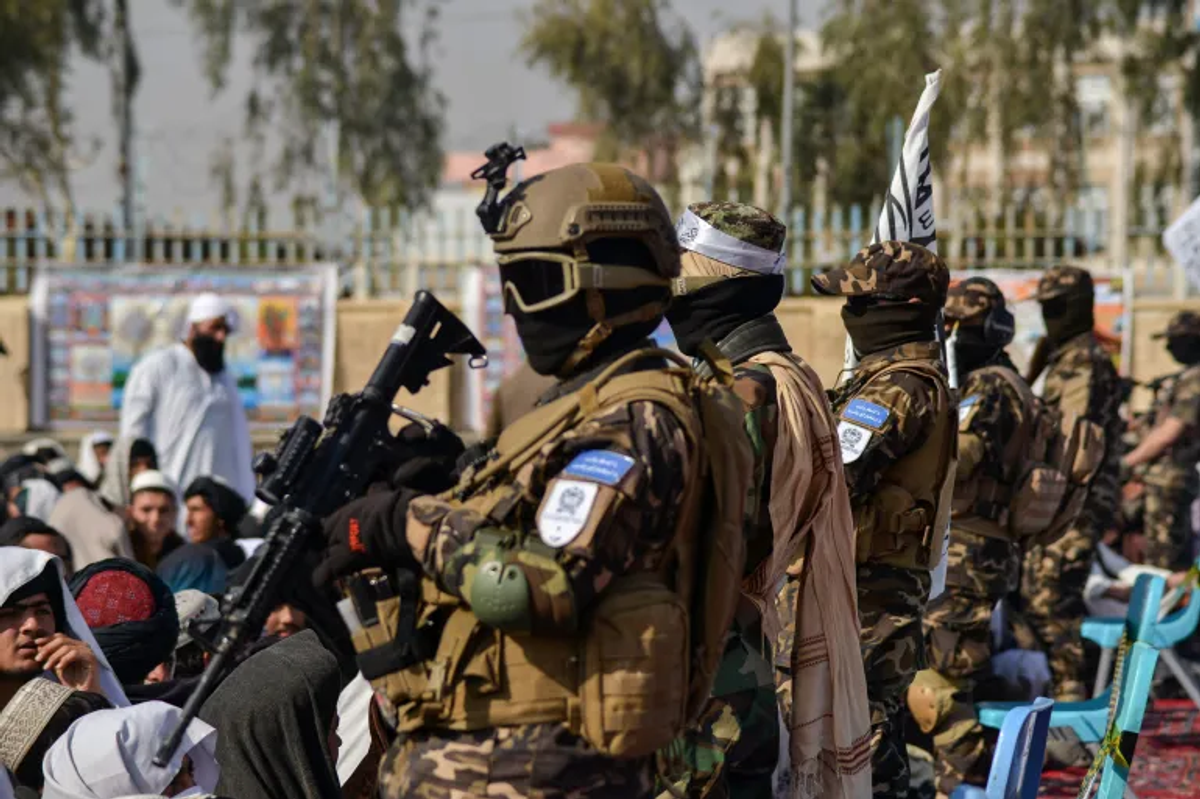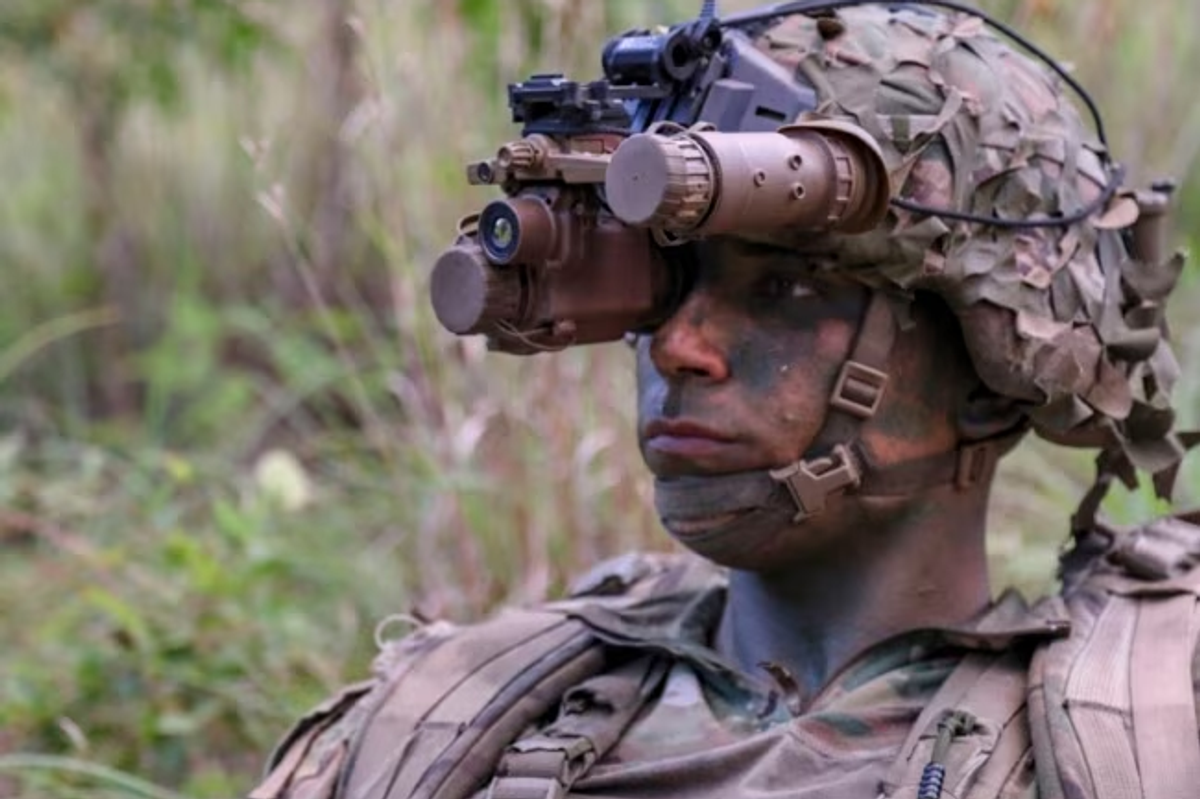News Desk
The News Desk provides timely and factual coverage of national and international events, with an emphasis on accuracy and clarity.

Members of the Taliban Badri 313 unit stand guard as newly recruited Taliban members who graduated from the Islamic Javadiya Madrassa attend a ceremony in Kandahar.
AFP/File
After two decades of war, the U.S. withdrawal from Afghanistan in 2021 was messy, abrupt, and dangerously unfinished. Among the most enduring legacies of the American exit is not the fall of Kabul or the return of the Taliban, but something far less visible and far more lethal: the thousands of advanced U.S. weapons now circulating across Pakistan’s fault lines of insurgency.
These arms — originally meant to bolster the now-defunct Afghan National Army — are fueling deadly uprisings. Pakistan’s law enforcement and security agencies are confronting a new and more dangerous wave of insurgents armed not just with ideology but with American-made assault rifles, night-vision goggles, and battlefield communications equipment.
This is no longer a speculative risk. It’s a reality, and it’s already costing lives.
The weapon trail: From Connecticut to conflict
As reported by The Washington Post, weapons like the M4A1 carbine rifle — manufactured in the U.S. and shipped to Afghanistan — have surfaced in militant attacks in Pakistan, including a March 2025 train hijacking that killed 26 people.
Pakistan’s security agencies have confirmed the recovery of dozens of such weapons, many traced directly to American stockpiles intended for Afghan forces.

The Special Inspector General for Afghanistan Reconstruction (SIGAR) estimated that more than $7 billion worth of U.S. equipment was still in Afghanistan when the last American troops left. Much of it, according to both open-source analysis and U.S. government admissions, is now in Taliban hands.
A Taliban official told Al Jazeera that the group seized more than 300,000 light arms, 26,000 heavy weapons, and around 61,000 military vehicles.
From Kabul’s fall to Darra’s bazaar
The illicit weapons bazaar in Khyber Pakhtunkhwa’s Darra Adamkhel experienced a dramatic surge in activity after the Taliban’s takeover. Vendors recall American arms flooding into the market at scrap prices, with advanced gear like night-vision goggles selling for less than $300.
Tehreek-e-Taliban Pakistan (TTP) operatives have confirmed that they acquired large amounts of U.S. gear during this period. This surge in capability has translated into a visible and brutal tactical shift. Militants now operate with battlefield sophistication, using thermal optics and night-vision scopes to ambush Pakistani forces in the dark, turning once-uneven firefights into asymmetric slaughters.

“They could see us, but we couldn’t see them,” said Ahmad Hussain, a Pakistani special forces officer injured in an ambush last year. His story is echoed by dozens more on the frontlines of this war.
The TTP has released numerous videos of sniper attacks on security check posts along Pakistan's western border with Afghanistan over the last few years.
BLA, TTP, and the dacoits: An unholy alliance
What was once a separatist issue in the restive province of Balochistan has now morphed into a militarized insurgency aided by U.S. firepower. The Balochistan Liberation Army (BLA) is reportedly deploying U.S. rifles and grenade launchers in ambushes and sabotage operations, including the deadly March train attack.
In Punjab, a different threat is emerging: heavily armed criminal gangs in the Katcha area are now utilizing advanced U.S. weapons. According to Punjab police, these dacoits can hit security personnel from two kilometers away — a range and precision previously unheard of in South Punjab's riverine region.
There is also growing concern that the TTP is coordinating with these dacoits and separatist groups, as joint evidence of their presence emerges in ongoing operations.
Even the Sindh police are now dealing with the fallout. Criminals and militants displaced by counterinsurgency operations in Punjab have migrated to southern border zones, overwhelming regional security forces ill-equipped to deal with enemies possessing U.S. military-grade hardware.
Taliban’s denial and Islamabad’s response
Islamabad has repeatedly urged the de facto Afghan Taliban government to secure these weapons and prevent their spillover. In January, Pakistan’s Ministry of Foreign Affairs warned that these arms represent a “profound concern for the safety and security” of the country. Yet, the Taliban maintain that the weapons are “secure in the depots” — a claim starkly contradicted by both on-the-ground evidence and UN reports that suggest rank-and-file Taliban fighters are supplying groups like the TTP.
Pakistan’s frustration is growing. Last month, Foreign Minister Ishaq Dar welcomed U.S. National Security Advisor Michael Waltz’s acknowledgment of the issue and President Trump’s announcement to pursue the retrieval of abandoned U.S. military gear. But it seems like a long shot as of now.

In theory, Washington could negotiate with the Taliban to buy back or disable these weapons. But in reality, President Donald Trump had previously bluntly admitted, “We left tens of billions of dollars’ worth of equipment behind … all the top-of-the-line stuff.” The Pentagon has essentially written off any recovery, claiming that the responsibility lies with the now nonexistent Afghan government.
America’s forgotten aftermath
It’s easy for Washington to walk away from this problem. But the consequences of its policy decisions continue to reverberate — in bloody ambushes, destabilized borders.
As South Asia analyst Michael Kugelman warned, Pakistan risks “falling back into that terrible period between 2009 and 2014, when the country was a major magnet for terrorism.” The only difference is that today’s militants are better armed, better trained, and more technologically equipped.
For Pakistan, the influx of these weapons is not just a law-and-order problem. It’s a national security crisis. For the United States, it is perhaps a stark reminder that in modern warfare, the end of an occupation does not necessarily mean the end of its consequences.










Comments
See what people are discussing